Loss
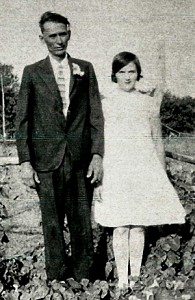 The Christmas season is always exciting, for old and young alike, and Christmas Eve is often a very hard day to settle down for. The reasons for the excitement vary. They are usually centered around the Christmas holiday, but not always. For my mother’s family, Christmas Eve holds an extra special significance because it was also their parents, wedding anniversary. Grandma Hattie and Grandpa George Byer were married on December 24, 1927. I always wondered why people would pick a holiday to get married on, but in times past, it was somewhat common. People could not easily get all their family members into town for a wedding, but people were often already getting together for a holiday. Of course, weddings weren’t often the great big affair that they can be these days either. Often the bride simply wore her Sunday dress, and carried a bouquet of wild flowers. I suppose it would be similar to the weddings held at the justice of the peace these days.
The Christmas season is always exciting, for old and young alike, and Christmas Eve is often a very hard day to settle down for. The reasons for the excitement vary. They are usually centered around the Christmas holiday, but not always. For my mother’s family, Christmas Eve holds an extra special significance because it was also their parents, wedding anniversary. Grandma Hattie and Grandpa George Byer were married on December 24, 1927. I always wondered why people would pick a holiday to get married on, but in times past, it was somewhat common. People could not easily get all their family members into town for a wedding, but people were often already getting together for a holiday. Of course, weddings weren’t often the great big affair that they can be these days either. Often the bride simply wore her Sunday dress, and carried a bouquet of wild flowers. I suppose it would be similar to the weddings held at the justice of the peace these days.
The reasons for the date and the simplicity of a wedding really didn’t make much difference, especially concerning my grandparents, because they were very much in love all of the years of their married lives together. I still remember all the times that Grandpa looked at Grandma with total love in his eyes. Grandma always knew that Grandpa loved her very much. Their marriage was blessed with nine children, four of whom are now in Heaven with them. They also have five sons-in-law and several grandchildren and great grandchildren in Heaven with them too. I would imagine that all of them are having a wonderful time there, because there are no tears and no sadness there. Of course, we here, who are left behind miss all of them terribly, and can’t wait to see them again.
Grandpa was a hard worker, who held many jobs in his lifetime. He was always a very respected worker. They 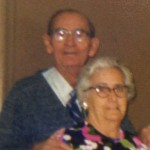
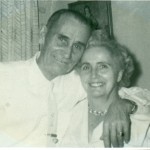 knew he could be counted on to be there and to do his job well. Grandma was always a stay-at-home mom, who never learned to drive a car. It was just something she saw no need for. She worked in the home, and she cooked…man could she cook!! And there was always plenty of food on her table…no matter how many extras might show up. No one was turned away, and Grandma’s table was famous in this area. Today would have been my grandparents’ 91st anniversary. Happy anniversary in Heaven, Grandma and Grandpa. We love and miss you both very much.
knew he could be counted on to be there and to do his job well. Grandma was always a stay-at-home mom, who never learned to drive a car. It was just something she saw no need for. She worked in the home, and she cooked…man could she cook!! And there was always plenty of food on her table…no matter how many extras might show up. No one was turned away, and Grandma’s table was famous in this area. Today would have been my grandparents’ 91st anniversary. Happy anniversary in Heaven, Grandma and Grandpa. We love and miss you both very much.
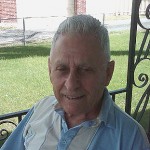
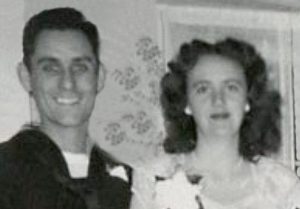 Two days ago, I wrote a story in celebration of my Uncle George Wave Hushman’s 92nd birthday. Little did I now that it would also be the day of his home-going, but it was. It is a rather rare thing, except in infant deaths, for someone to be born and die on the same day, but that is what my Uncle George did. He was born on December 20, 1926 in Rock River, Wyoming, and went home to Heaven on December 20, 2018 in Mills, Wyoming…exactly 92 years later.
Two days ago, I wrote a story in celebration of my Uncle George Wave Hushman’s 92nd birthday. Little did I now that it would also be the day of his home-going, but it was. It is a rather rare thing, except in infant deaths, for someone to be born and die on the same day, but that is what my Uncle George did. He was born on December 20, 1926 in Rock River, Wyoming, and went home to Heaven on December 20, 2018 in Mills, Wyoming…exactly 92 years later.
Uncle George led an unusual life, so I guess I shouldn’t be surprised that his home-going would be just as unusual. He lost his mother when he was just eleven years old. I’m not sure how long after her passing, before he was sent to the Wyoming State Children’s Home in Casper, Wyoming, but during those years, his guardian was listed as Ethel S. Kittle. Uncle George didn’t know much about his family for most of his life, but his dad, also named George Wave Hushman was in the Navy, stationed in the Philippines when he was killed in action on November 21, 1943…Uncle George was just 17 years old. To his knowledge, that left him very much alone in this world, except for his friend James Wesley Saint John ‘Wes” and Wes’ family, who had unofficially adopted him as a part of their family. Wes, who was three years older than Uncle George was lost at sea on September 9, 1943. While Uncle George didn’t know his father well, he did know his friend, and I find it unusual that he enlisted in the Navy too, but he did. His Draft Card listed his next of kin as WE Saint John. He mustered out on May 31, 1944, and was later listed among the wounded. I am grateful that he was one of those who made it home from the war. Uncle George, was first assigned to LCI(L) 23…Landing Craft Infantry (L)23. He later mustered out on USS Gurke (DD-783), a Gearing-class destroyer.
By 1946, Uncle George was released from the Navy, and was living in Mills, Wyoming, and falling in love with my aunt, Evelyn Byer, whom he married on September 1, 1947. He had found the love of his life, and he only wanted to be with her for the rest of his life…missing her terribly after she passed away on May 4, 2015. Aunt 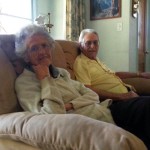
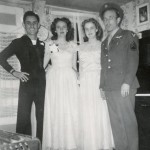 Evelyn and Uncle George would be blessed with five children, George Hushman, Susie Young, Shelly Campbell, Shannon Limmer, and Greg Hushman. They were also blessed with many grandchildren, great grand children, and great great grandchildren. Uncle George was also blessed to be able to reunite with his half siblings over the years, although their passings brought him a feeling of losing them twice. Now that they are together again in Heaven, Uncle George will never have to be away from his beloved Evelyn, or the other loved ones who had gone before him. Rest in peace Uncle George. We love and miss you very much.
Evelyn and Uncle George would be blessed with five children, George Hushman, Susie Young, Shelly Campbell, Shannon Limmer, and Greg Hushman. They were also blessed with many grandchildren, great grand children, and great great grandchildren. Uncle George was also blessed to be able to reunite with his half siblings over the years, although their passings brought him a feeling of losing them twice. Now that they are together again in Heaven, Uncle George will never have to be away from his beloved Evelyn, or the other loved ones who had gone before him. Rest in peace Uncle George. We love and miss you very much.
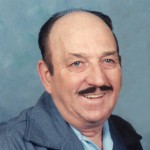 Time waits for no man, and it doesn’t slow down or stop while we grieve a loss. As a child and on into adulthood, it never occurred to me that I would live one single day without my dad. I can’t say why I thought that, because in retrospect, it was not really a logical way to think, but then are matters of the heart ever logical. It doesn’t matter if you are talking about romantic love or the love you have for parents or siblings. They should just never leave you, whether that is logical or not.
Time waits for no man, and it doesn’t slow down or stop while we grieve a loss. As a child and on into adulthood, it never occurred to me that I would live one single day without my dad. I can’t say why I thought that, because in retrospect, it was not really a logical way to think, but then are matters of the heart ever logical. It doesn’t matter if you are talking about romantic love or the love you have for parents or siblings. They should just never leave you, whether that is logical or not.
Nevertheless, as illogical as it seemed to me, my dad, Al Spencer went home to be with the Lord eleven years ago today December 12, 2007 at precisely 12:00pm. The world seemed so empty when we left the hospital that day, and I found myself wondering how it could be that the world and time kept moving when everything for my dad stopped at that moment. Again these were not the thoughts of a person in a rational state of mind,but rather a person who had just lost a beloved parent. I knew that my dad was in Heaven,because he had always believed in Jesus as his Saviour, but he was no longer here with us…his wife, Collene Spencer; daughters, Cheryl Masterson, Caryn Schulenberg, Caryl Reed, Alena Stevens, and Ally Hadlock; and their families, and that was what made the whole world…just wrong.
As the years go by…faster than any of us ever dreamed they would, we cherish the memories of our dad more and more,because they are all we have…because our dad and our mom are in our future now. My thoughts go back to the many times my girls, Corrie Petersen and Amy Royce and I had lunch at their house. It’s odd, I suppose that those lunches are what comes to mind, but they have been coming to my mind a lot these past 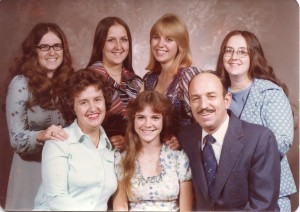 few days. I remember going over to their house at lunch. Mom would make her specialties, Stuffed Tomatoes or Chicken salad with Shoe String Potatoes. As we gathered at the table to eat, the conversation covered everything from our families to how our jobs were going. Mom and Dad didn’t care what we talked about, they just wanted to be a part of our lives. Mom and Dad were always all about family. They loved their kids, grandkids, great grandkids, and great great grandkids. They felt so blessed by the family they started beginning back in 1954. Family was all they ever wanted. Family was everything. I still can’t believe that my dad has been in Heaven for eleven years today. We love you Dad, and miss you very much. We will see you in Heaven one day.
few days. I remember going over to their house at lunch. Mom would make her specialties, Stuffed Tomatoes or Chicken salad with Shoe String Potatoes. As we gathered at the table to eat, the conversation covered everything from our families to how our jobs were going. Mom and Dad didn’t care what we talked about, they just wanted to be a part of our lives. Mom and Dad were always all about family. They loved their kids, grandkids, great grandkids, and great great grandkids. They felt so blessed by the family they started beginning back in 1954. Family was all they ever wanted. Family was everything. I still can’t believe that my dad has been in Heaven for eleven years today. We love you Dad, and miss you very much. We will see you in Heaven one day.
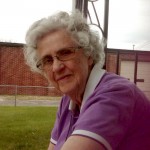 My mom always had quite a bit in common with her older sister, Evelyn Hushman. My mom was close to all her sisters, but she and Aunt Evelyn had things in common that she maybe didn’t with some of the other sisters. I think it’s possible that it was their husbands got along very well. In fact, even before my mom was married, my parents, Al and Collene Spencer double dated with Aunt Evelyn, and her husband, my Uncle George. After both couples were married and had children, we all spent lots of time together. I remember growing up playing with the Hushman kids, and because they
My mom always had quite a bit in common with her older sister, Evelyn Hushman. My mom was close to all her sisters, but she and Aunt Evelyn had things in common that she maybe didn’t with some of the other sisters. I think it’s possible that it was their husbands got along very well. In fact, even before my mom was married, my parents, Al and Collene Spencer double dated with Aunt Evelyn, and her husband, my Uncle George. After both couples were married and had children, we all spent lots of time together. I remember growing up playing with the Hushman kids, and because they 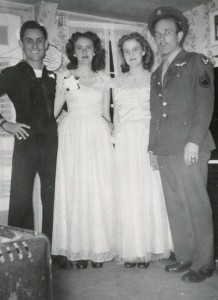 were all a little bit older than I was, they usually set the tone for the games. It didn’t matter, because it was always fun.
were all a little bit older than I was, they usually set the tone for the games. It didn’t matter, because it was always fun.
Later, my parents bowled on the same team on Monday nights with Aunt Evelyn and Uncle George. They bowled together for a number of years, and then they decided to quit, with the exception of Aunt Evelyn, who bowled for many years after. In fact, when she was bowling with her daughters, I substituted on their team many times. I enjoyed bowling with them, because it kept our families close.
As the years went by, they quit bowling too, and I began to see less and less of Aunt Evelyn. That made me sad. Everyone is so busy thee days, and before you know it, the ones you love have grown into their latter 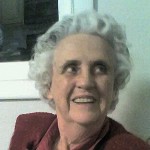 years, and you find yourself wondering where the time has gone. That was where I found myself with Aunt Evelyn, seeing her at the family Christmas party and the annual family picnic, and then not even at those. When Aunt Evelyn passed away on May 4, 2015, just a little over two months after my mom passed away, I found myself feeling very sad and lonely, because we had lost them both within such a short time, but I guess the sisters, who always had so much in common, were together again, and enjoying their new lives. Today would have been Aunt Evelyn’s 90th birthday. Happy birthday in Heaven Aunt Evelyn. We love and miss you very much.
years, and you find yourself wondering where the time has gone. That was where I found myself with Aunt Evelyn, seeing her at the family Christmas party and the annual family picnic, and then not even at those. When Aunt Evelyn passed away on May 4, 2015, just a little over two months after my mom passed away, I found myself feeling very sad and lonely, because we had lost them both within such a short time, but I guess the sisters, who always had so much in common, were together again, and enjoying their new lives. Today would have been Aunt Evelyn’s 90th birthday. Happy birthday in Heaven Aunt Evelyn. We love and miss you very much.
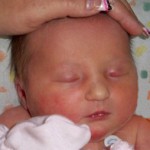 It is so hard to believe that another year has passed since my grand niece, Laila Spethman was born, back in 2010. I suppose the years would have been less shocking if we had been able to watch Laila grow up, but that was not to be, because just 18 days later, Laila went to Heaven, and our hearts were broken. This year, Laila would have turned 8, and she would have known her brothers, Xander, Zack, and Isaac, as well as her little sister Aleesia. It’s hard and yet pretty easy to imagine what Laila might have been like today. My guess is that she and her little sister would have been two of a kind. While it would have been Laila teaching Aleesia how to be the goofy little
It is so hard to believe that another year has passed since my grand niece, Laila Spethman was born, back in 2010. I suppose the years would have been less shocking if we had been able to watch Laila grow up, but that was not to be, because just 18 days later, Laila went to Heaven, and our hearts were broken. This year, Laila would have turned 8, and she would have known her brothers, Xander, Zack, and Isaac, as well as her little sister Aleesia. It’s hard and yet pretty easy to imagine what Laila might have been like today. My guess is that she and her little sister would have been two of a kind. While it would have been Laila teaching Aleesia how to be the goofy little 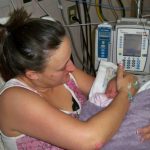 girl they both would have been, I have to think that Aleesia would have taught Laila a thing or two as well. The two little girls, younger sisters of three brothers, would have grown up much like Aleesia has…well able to handle life as a girl with older brothers…part Tomboy and part Princess.
girl they both would have been, I have to think that Aleesia would have taught Laila a thing or two as well. The two little girls, younger sisters of three brothers, would have grown up much like Aleesia has…well able to handle life as a girl with older brothers…part Tomboy and part Princess.
It always makes me sad that Laila never got the chance to become that little girl who was a perfect mix…just like her little sister. Instead, Laila will always be the little princess and sleeping beauty, waiting in Heaven for 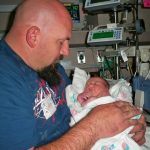 the day when we all meet her there and get to know her. Until then, she is missed very much, and loved so much. I would say that she was loved more than she could know, but I think she knows now. And while she loves us all too, right now she is busy getting to know her grandparents and great grandparents who are in Heaven with her. And there is no sadness there, because Laila knows that we will all be together again in Heaven, and that this time apart is like a drop in a bucket. While we view the years as long and many, she sees them as only seconds ago. Today would have been Laila’s 8th birthday. Happy birthday in Heaven Lila. We love and miss you very much.
the day when we all meet her there and get to know her. Until then, she is missed very much, and loved so much. I would say that she was loved more than she could know, but I think she knows now. And while she loves us all too, right now she is busy getting to know her grandparents and great grandparents who are in Heaven with her. And there is no sadness there, because Laila knows that we will all be together again in Heaven, and that this time apart is like a drop in a bucket. While we view the years as long and many, she sees them as only seconds ago. Today would have been Laila’s 8th birthday. Happy birthday in Heaven Lila. We love and miss you very much.
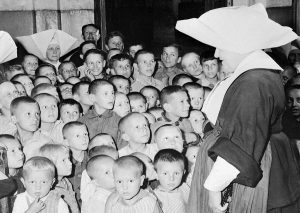 During the years of World War II, so much destruction brought with it the loss of jobs and homes. Along with the loss of jobs came poverty for many people. The smallest necessity became a “luxury” to people who had no problem making a living before. Many children were caught in the post-war poverty, because they lost their parents in the war. The orphanages were filled with children who were still in a daze, and trying to learn to be pretty much on their own, while still under the supervision of the state. I can only imagine how these little ones must have felt. Their parents were gone, they were grieving, and they were tossed into a strange building with many other children, all in the same boat. I’m sure the people running the orphanage did their best to comfort the children, but there were just so many of them.
During the years of World War II, so much destruction brought with it the loss of jobs and homes. Along with the loss of jobs came poverty for many people. The smallest necessity became a “luxury” to people who had no problem making a living before. Many children were caught in the post-war poverty, because they lost their parents in the war. The orphanages were filled with children who were still in a daze, and trying to learn to be pretty much on their own, while still under the supervision of the state. I can only imagine how these little ones must have felt. Their parents were gone, they were grieving, and they were tossed into a strange building with many other children, all in the same boat. I’m sure the people running the orphanage did their best to comfort the children, but there were just so many of them.
I’m sure that joy was stranger to most of the children. And I’m sure that the people who cared for them were looking for any way to put a smile on the faces of the children. Little did they know, how such a small thing as shoes, could change everything. They found out, when the Junior Red Cross in the United States of America put together boxes of what most of us would consider necessities to give to the children in Europe.
One six year old Austrian boy named Werfel, was photographed when he got a new pair of shoes at the Am Himmel orphanage, donated to him in the Christmastime care box. The picture taken of little Werfel, was enough to bring tears to the eyes of anyone who saw it. They may have been happy tears, but they were highly emotional tears nevertheless. Most kids these days, would be almost disappointed to receive a pair o shoes as 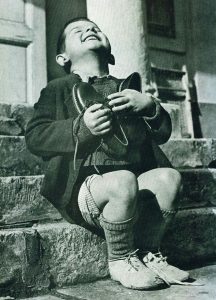 a gift…unless they were the latest in cool shoes. Little Werfel was beyond happy. He held the shoes to his chest and looked to the sky, as I he couldn’t possibly contain his happiness. The photographer probably took the picture through tear filled eyes. I know that’s what I would have done as the photographer. It was impossible not to be filled with emotion. “The photograph was first published in LIFE magazine on December 30, 1946 (on page 22) and later, again, on September 24, 1951 (on page 180). The photograph was shot by Gerald Waller, in 1946, and was titled “New Shoes”. The little boy, Werfel, was among the children who were brought to the USA after being deported from Israel / Palestine, where they arrived after liberation from the concentration camps. The image was published with the following caption in the 1946 issue. “EUROPE’S CHILDREN – Christmas brings joy and sadness.”
a gift…unless they were the latest in cool shoes. Little Werfel was beyond happy. He held the shoes to his chest and looked to the sky, as I he couldn’t possibly contain his happiness. The photographer probably took the picture through tear filled eyes. I know that’s what I would have done as the photographer. It was impossible not to be filled with emotion. “The photograph was first published in LIFE magazine on December 30, 1946 (on page 22) and later, again, on September 24, 1951 (on page 180). The photograph was shot by Gerald Waller, in 1946, and was titled “New Shoes”. The little boy, Werfel, was among the children who were brought to the USA after being deported from Israel / Palestine, where they arrived after liberation from the concentration camps. The image was published with the following caption in the 1946 issue. “EUROPE’S CHILDREN – Christmas brings joy and sadness.”
It was said that, “For many of Europe’s children there was a Santa Claus this Christmas. When a big box from the American Red Cross arrived at Vienna’s Am Himmel orphanage, shoes and coats and dresses tumbled out. Like the youngster (in the picture), the children who had seen no new clothes throughout the war smiled to high heaven. But for thousands of other European children there was no Santa Claus. When a boatload of illegal Jewish immigrants arrived at Haifa, Palestine recently, two Polish children (opposite) got separated from their parents. Tears filled the eyes of the boy, and his wan sister clutched him protectively. They were later reunited with their parents, but the whole family was shipped to Cyprus.”
The picture has stayed in my memory since the first time I saw it. To see that little boy so overjoyed…over shoes, was so beautiful. The photographer caught the picture perfectly. That moment was very likely one of the first truly happy moments that little boy had felt in quite some time. An adult, no matter the need would never 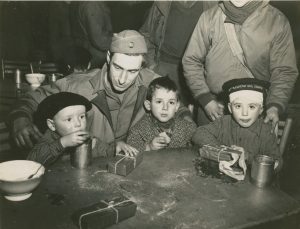 have shown such deep joy, probably because they would still be wrapped up in the poverty of the time, while the child was able to look beyond all that,and see the pure joy of the gift. The child could simply enjoy and cherish what has just been given to him, even though he was living in an orphanage…even though historical events had just unfolded,robbing him of his comfortable life…even though these were hand-me-downs. It made no difference to this boy, and it reminds us of how flawed our thinking is. We tend to look at the negatives in life and focus on them. Not this boy. He was happy with the tiniest positive thing that came into his life. It’s a lesson we should all learn. Sometimes we all need to appreciate the little things in life.
have shown such deep joy, probably because they would still be wrapped up in the poverty of the time, while the child was able to look beyond all that,and see the pure joy of the gift. The child could simply enjoy and cherish what has just been given to him, even though he was living in an orphanage…even though historical events had just unfolded,robbing him of his comfortable life…even though these were hand-me-downs. It made no difference to this boy, and it reminds us of how flawed our thinking is. We tend to look at the negatives in life and focus on them. Not this boy. He was happy with the tiniest positive thing that came into his life. It’s a lesson we should all learn. Sometimes we all need to appreciate the little things in life.
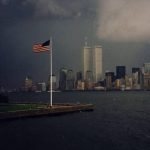 I saw picture of the New York skyline that was taken on September 10, 2001, about 24 hours before the attacks on the World Trade Center on September 11, 2001. It was profound. The picture, taken so innocently, probably by a tourist, foretold nothing of the horror that was eminent. No one knew. No one suspected. No one thought such an attack could ever happen on American soil again, but it did, and just 24 hours after this picture was taken, we would all know that it definitely could, and did happen here again.
I saw picture of the New York skyline that was taken on September 10, 2001, about 24 hours before the attacks on the World Trade Center on September 11, 2001. It was profound. The picture, taken so innocently, probably by a tourist, foretold nothing of the horror that was eminent. No one knew. No one suspected. No one thought such an attack could ever happen on American soil again, but it did, and just 24 hours after this picture was taken, we would all know that it definitely could, and did happen here again.
Just 24 hours after this picture was taken, the lives of 2,996 people would be over (including the 19 hijackers). In addition, more than 6,000 people would be injured. These immediate deaths included 265 on the four planes (including the terrorists), 2,606 in the World Trade Center and in the surrounding area, and 125 at the Pentagon. The September 11th attacks were the deadliest terrorist attack in world history, and the most devastating foreign attack on United States soil since the attack on Pearl Harbor on December 7, 1941…the last time we had thought it could never happen here.
We could go over the deaths of the people here, but we all know the horror that took place. We wanted to close our eyes to the terrible images, and yet, in utter disbelief, we could not look away. We hoped against hope, and prayed without ceasing, that by some miracle, more people would be found alive. Still, as time went on, we knew there would be no more survivors. Nevertheless, we waited and we watched. We watched with hope, but we also watched with anger. There was no reason for such a horrible attack on our nation. We weren’t at war, and we had done nothing to hurt these attackers. Yet, somehow, in their twisted, evil minds, we had. And they reveled in the way that they had managed to secretly pull this attack off.
Now, 17 years later, with so many of our young adults almost unaware of the attacks of September 11, 2001, 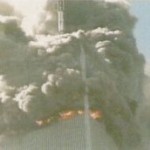
 we find ourselves in a place where many people think it could never happen here again, and yet, our world is actually more dangerous now than it was then. We must always be alert. We must never forget those attacks. Never assume that evil will leave our nation alone, if we try to be nice to it. Appeasement only makes us look vulnerable, and that opens the door to attack. It has been proven time and time again. Just like the picture of the New York skyline on September 10, 2001 seemed so serene, it held a dark secret that would only be revealed in the stark daylight of September 11.
we find ourselves in a place where many people think it could never happen here again, and yet, our world is actually more dangerous now than it was then. We must always be alert. We must never forget those attacks. Never assume that evil will leave our nation alone, if we try to be nice to it. Appeasement only makes us look vulnerable, and that opens the door to attack. It has been proven time and time again. Just like the picture of the New York skyline on September 10, 2001 seemed so serene, it held a dark secret that would only be revealed in the stark daylight of September 11.
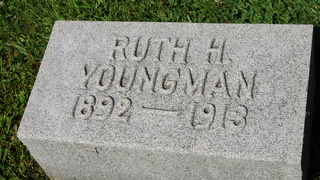 The headline read “Wedding Gown To Be Her Shroud.” The newspaper article was about a horrible tragedy, that took place just four days after the wedding of my husband, Bob’s 6th cousin 3 times removed, Ruth Schulenberg to Wilberd Youngman. The wedding took place on November 26, 1913, and was a large social affair for the smaller town of Tolono, Illinois, population of about 700, at the time. Ruth Schulenberg, was the daughter of Mr and Mrs Henry Schulenberg, and was a graduate of Saint Mary’s of the Wood where she was a member of a prominent sorority. Wilberd Youngman employed as a draughsman by the Burr Company of Champaign, Illinois. The wedding took place at Saint Patrick’s Catholic Church in Tolono.
The headline read “Wedding Gown To Be Her Shroud.” The newspaper article was about a horrible tragedy, that took place just four days after the wedding of my husband, Bob’s 6th cousin 3 times removed, Ruth Schulenberg to Wilberd Youngman. The wedding took place on November 26, 1913, and was a large social affair for the smaller town of Tolono, Illinois, population of about 700, at the time. Ruth Schulenberg, was the daughter of Mr and Mrs Henry Schulenberg, and was a graduate of Saint Mary’s of the Wood where she was a member of a prominent sorority. Wilberd Youngman employed as a draughsman by the Burr Company of Champaign, Illinois. The wedding took place at Saint Patrick’s Catholic Church in Tolono.
After their wedding, the young couple was on their honeymoon, in Kokomo, Indiana, where they had attended church at the Kokomo Catholic Church. Following the church service, they were on their way to a big wedding dinner in their honor at the country residence of a neighbor of Youngman’s cousin, Edward Grishaw, who was 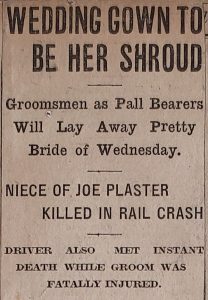
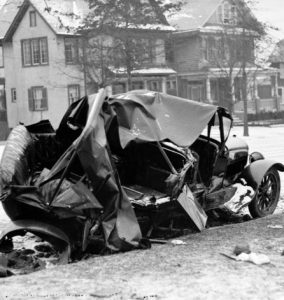 transporting the couple in a closed carriage. As the carriage began its crossing of the tracks of the Lake Erie and Western Railway, Grishaw failed for look for trains, and pulled out in front of the Lake Erie train going full speed. The train ripped through the car, and by the time the train could stop and the crew reached the car’s occupants, Ruth Schulenberg and Edward Grishaw were dead. Wilberd Youngman was critically injured, and not expected to live.
transporting the couple in a closed carriage. As the carriage began its crossing of the tracks of the Lake Erie and Western Railway, Grishaw failed for look for trains, and pulled out in front of the Lake Erie train going full speed. The train ripped through the car, and by the time the train could stop and the crew reached the car’s occupants, Ruth Schulenberg and Edward Grishaw were dead. Wilberd Youngman was critically injured, and not expected to live.
Amazingly, Wilberd Youngman did live…for eleven months. Youngman was taken to a hospital in Chicago, but his prognosis was grim. People just don’t come back from being hit by a train that ripped their car apart, and yet he was still alive, and actually recovering from his injuries…the visible injuries anyway. Youngman had lost so much that November day, and he was struggling to move forward. Ruth Schulenberg had been his soulmate, and his very best friend. She was the love of his life, and he knew there could never be another woman for him. Wilberd Youngman was not a man who would commit suicide, but he also could not recover from this deepest injury…the one that broke his heart. Slowly, over the eleven months that followed the saddest day of 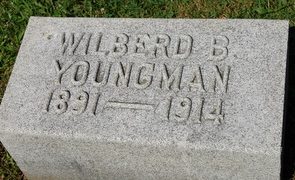 his life, Wilberd Youngman dwindled away. it wasn’t a refusal of food and water, but rather a refusal to go on without his precious Ruth. Finally, on October 24, 1914, just short of 11 months after that awful day…November 30, 1913, Wilberd Youngman could no longer go on living, and so, with his parents by his side, he simply passed away. The final cause of death was listed as a broken heart. That, to me was the saddest cause of death I had ever heard. Because of the loss of his wife, Wilberd simply had no desire to live either. He tried to recover…physically, but his heart was no longer in it, and he finally just gave up and quit trying. The Honeymoon Tragedy had finally claimed it’s last victim.
his life, Wilberd Youngman dwindled away. it wasn’t a refusal of food and water, but rather a refusal to go on without his precious Ruth. Finally, on October 24, 1914, just short of 11 months after that awful day…November 30, 1913, Wilberd Youngman could no longer go on living, and so, with his parents by his side, he simply passed away. The final cause of death was listed as a broken heart. That, to me was the saddest cause of death I had ever heard. Because of the loss of his wife, Wilberd simply had no desire to live either. He tried to recover…physically, but his heart was no longer in it, and he finally just gave up and quit trying. The Honeymoon Tragedy had finally claimed it’s last victim.
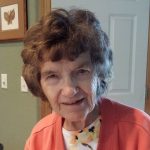
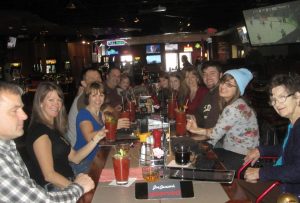 Four years ago, my mom, Collene Spencer; my sister, Cheryl Masterson; and I took a trip back to Superior, Wisconsin, which is where Cheryl and I were born. While we were there, we were invited to Julie Carlson Soukup’s home for dinner. My mom knew the parents of these cousins who had welcomed us into their home. Cheryl and I did too, but it had been a number of years since we had seen them, and certainly, most of the cousins themselves were totally new to us. We watched as the Carlson kids brought their mother, Carol Carlson to the dinner. She had been dealing with Lewy Body Dementia, which is much like Alzheimer’s disease, but with the added issue of motor problems. These kids were so careful with her, and so determined that she be able to come for this visit. It brought tears to my eyes to see such love. Having been a caregiver for a long time, I knew how much work caregiving is, but they didn’t care what it took. She was their mom.
Four years ago, my mom, Collene Spencer; my sister, Cheryl Masterson; and I took a trip back to Superior, Wisconsin, which is where Cheryl and I were born. While we were there, we were invited to Julie Carlson Soukup’s home for dinner. My mom knew the parents of these cousins who had welcomed us into their home. Cheryl and I did too, but it had been a number of years since we had seen them, and certainly, most of the cousins themselves were totally new to us. We watched as the Carlson kids brought their mother, Carol Carlson to the dinner. She had been dealing with Lewy Body Dementia, which is much like Alzheimer’s disease, but with the added issue of motor problems. These kids were so careful with her, and so determined that she be able to come for this visit. It brought tears to my eyes to see such love. Having been a caregiver for a long time, I knew how much work caregiving is, but they didn’t care what it took. She was their mom.
I didn’t know Carol well, but over the years, I watched as the Carlson family centered life around her. They took her so many places, and everywhere they went was an event, documented with lots of pictures. They were, of course, building their memories, knowing that the future was uncertain. They didn’t want to think about the day when Carol would no longer be with them. Right before we came for that visit, they had just had to move Carol into an nursing home, because she could no longer live on her own. Once again they showed her the greatest love they could have for her. They told her about her life, the life that had begun to slip away from her memory files. They needed to preserve it for her somehow.
When Carol passed away, on August 2nd, 2018, I began to recall the many beautiful things the Carlson family had done for her, but I realized that I didn’t really know much about her life. I wanted her children to share some of their favorite memories with me, because I knew that I wanted to write a tribute to their beautiful mother. They decided that they would send me a copy of the letter written by her oldest daughter, Laurie Carlson Stepp at the time they moved Carol into the nursing home. The children put together a scrap book filled with letters from her children and grandchildren, poems she had written, stories about her, such as her sayings…things they had heard her say all their lives, and pictures for her to see. It was their gift to their mother…her memories. They were giving them back to her.
I could never begin to write her memories with the beauty that her children and grandchildren did. Their 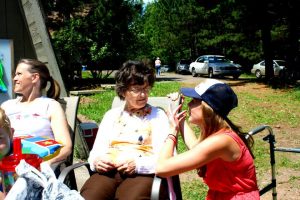
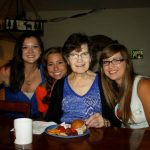 memories of her were their gift of love to her, and that is beyond special. Nevertheless, I want to try to highlight some of the wonderful things Carol Schumacher Carlson did in her lifetime. The reality is that Carol almost didn’t exist. Laurie tells that story in her letter to her mom, “Your parents, Fred and Anna Schumacher already had one lovely daughter, Beatrice. When she was born, there were serious difficulties and the doctor told Fred that he would have to choose between his wife and the baby. He chose his wife……she chose the baby! They were both saved, but the doctor cautioned against having any more children. So that is why you Carol were a miracle baby.” The faith of her parents brought about Carol’s life, as well as nine siblings after her. The letter told of the help Carol gave her mom with her younger siblings, Leslie, Carl, Margaret, Gilbert, Delwin, Noreen, Bernice, Bob, and Dale.
memories of her were their gift of love to her, and that is beyond special. Nevertheless, I want to try to highlight some of the wonderful things Carol Schumacher Carlson did in her lifetime. The reality is that Carol almost didn’t exist. Laurie tells that story in her letter to her mom, “Your parents, Fred and Anna Schumacher already had one lovely daughter, Beatrice. When she was born, there were serious difficulties and the doctor told Fred that he would have to choose between his wife and the baby. He chose his wife……she chose the baby! They were both saved, but the doctor cautioned against having any more children. So that is why you Carol were a miracle baby.” The faith of her parents brought about Carol’s life, as well as nine siblings after her. The letter told of the help Carol gave her mom with her younger siblings, Leslie, Carl, Margaret, Gilbert, Delwin, Noreen, Bernice, Bob, and Dale.
Carol was a hard worker all her life. She worked at Hills Brothers Dairy, then for a lawyer in Billings Park babysitting their children, as a waitress at the Princess Sweet Shop, at Phoenix Hosiery, at Twin Ports Dairy…where she did office work, and at Kempenski Glass Company. All these were jobs, but her real life’s work was to be the mother of her children. Carol married Donald John Carlson on August 21, 1954, and they would be blessed with Donny, Laurie, Steve, Dave, Jim and twins – Julie and Jeanne. Carol also had bonus children, Bonnie and Randy, from Don’s first marriage. Carol was a housewife, and very good at her job. They grew a big garden, canned and froze enough food to keep the family in vegetables most of the year. Their dad would come home and there was always a flurry of activity and fun. Carol cooked, cleaned, sewed, and took care of her family, and still had time to help out others too. The children always came home from school to some kind of homemade snack, but more importantly…they came home to their mom, Carol, who welcomed them with open arms. Carol baked 5 loaves of bread every day and packed countless lunches. She sewed clothes for her family and often surprised them with something new that they needed after staying up all night working with her sewing machine until it was finished. She made clothes, quilts, tents, and just about anything that could be made with cloth for her family and for her grandchildren too. She made Indian costumes with real tepees, which have been used by most of her grandsons. She made a pair of sandals for Jon and Josh when they were starting to walk, Prom dresses, bridesmaid dresses, suits, pants, skirts, shirts, blouses…the family was always wearing something Carol had made. They have always felt so blessed to have Carol in their lives.
When I set out to write this tribute to Carol Schumacher Carlson, I wanted it to be about the amazing things 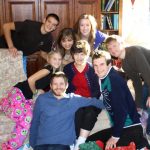
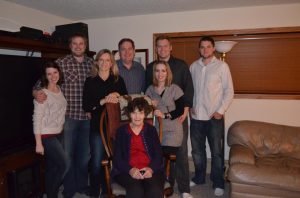 she did for those she loved. Little did I know that it would be about the amazing children she raised, but in reality, it had to be about her amazing children, because that was what Carol was all about. Her whole life was spent giving of herself to those she loved and cared about. It was Carol, who along with her husband, Don raised these kids to be the loving, responsible adults that they have become. That, in itself, is a tribute to Carol. Her hard work for her family, was her gift to them, and they were her reward…her legacy.
she did for those she loved. Little did I know that it would be about the amazing children she raised, but in reality, it had to be about her amazing children, because that was what Carol was all about. Her whole life was spent giving of herself to those she loved and cared about. It was Carol, who along with her husband, Don raised these kids to be the loving, responsible adults that they have become. That, in itself, is a tribute to Carol. Her hard work for her family, was her gift to them, and they were her reward…her legacy.
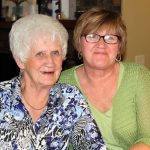 When I was a little girl, my family lived in Superior, Wisconsin. Those were wonderful years, but in more recent years we had not been back to Superior for a number of years. When my mom, Collene Spencer wanted to go back to Superior, my sister, Cheryl Masterson and I took her, since our dad had passed away by then. That, Ancestry, and Facebook opened up a whole new world for Cheryl and me. We got to know our cousins, and the list of cousins we know grows every day…or at least every year. This year, with the Schumacher Family Reunion, we knew we had to go, even though it would be without Mom this time. This trip was bittersweet, because of course, Mom was missing.
When I was a little girl, my family lived in Superior, Wisconsin. Those were wonderful years, but in more recent years we had not been back to Superior for a number of years. When my mom, Collene Spencer wanted to go back to Superior, my sister, Cheryl Masterson and I took her, since our dad had passed away by then. That, Ancestry, and Facebook opened up a whole new world for Cheryl and me. We got to know our cousins, and the list of cousins we know grows every day…or at least every year. This year, with the Schumacher Family Reunion, we knew we had to go, even though it would be without Mom this time. This trip was bittersweet, because of course, Mom was missing.
Nevertheless, we have had a wonderful time. When we were here the last time, our first cousins once removed, Les and Bev Schumacher had wanted us to come to their house, but our time was do limited, that we didn’t have time to. This time, their daughter, Cathy La Porte graciously invited us for dinner this evening. We got to meet her husband, Gary, as well as to see her brother, Brian Schumacher and his wife, Lisa again. It was simply a wonderful evening. Cathy is an excellent cook and we were treated to Walleye Pike and Northern Pike that Cathy’s husband, Gary caught in North Dakota with his brother this past 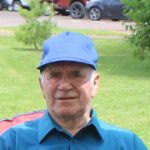 week. Wow!!! Was it good. Dessert was a Cherry Crumble that Lisa’s friend had given her, and everyone loved it.
week. Wow!!! Was it good. Dessert was a Cherry Crumble that Lisa’s friend had given her, and everyone loved it.
The evening was very enjoyable and will always be a sweet memory from our trip. The trip has gone by so fast, and what we thought was enough time, really wasn’t…it never is, is it? Nevertheless, the friendships (cousinships) formed will last for the rest of our lives, and while our parents weren’t there this time, we know they would be smiling…happy to see their daughters and granddaughter continue to reach out to the family as if they were with us. I guess we are carrying on the connections, and that would make them happy, and it makes me happy.

